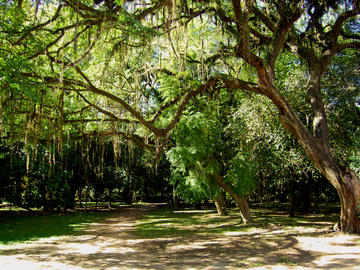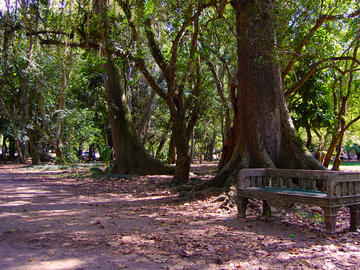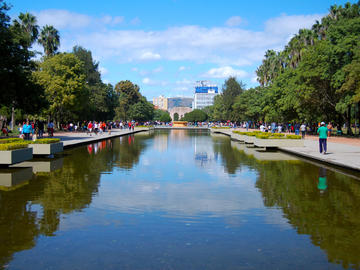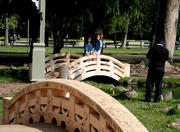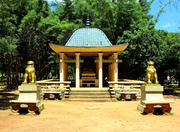Farroupilha or Redenção Park Picture 5
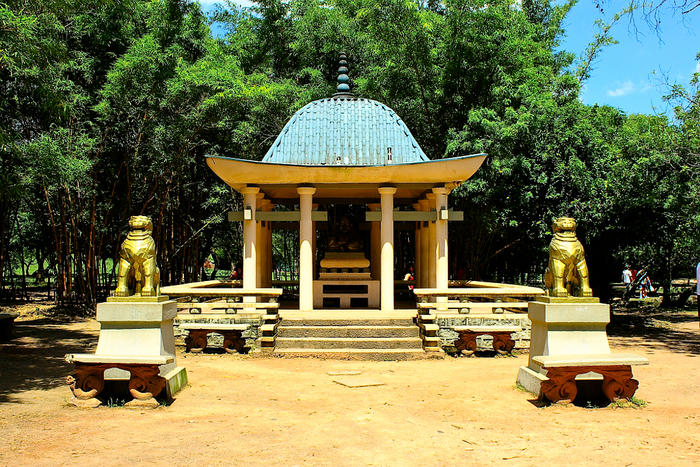
More information on Farroupilha Park in Porto Alegre Photo by: ToniProtto
Farroupilha Park in Porto Alegre
Farroupilha Park, also known as Redenção Park, is the most traditional and popular park in Porto Alegre, as a spot traditionally visited by Porto Alegre citizens in the hours of rest, either for sports or simply to drink a chimarrão with the family. The perimeter of the park is set on streets Setembrino and Luis Englert, and avenues Oswaldo Aranha, Joao Pessoa and Jose Bonifacio.
The story of Farroupilha Park merges with the history of the city of Porto Alegre. Arisen from an area located on the outskirts of the ancient city, it went slowly being increasingly surrounded by urban growth. Along the way, witnessed several political demonstrations, and popular culture. It has received many names, which help to understand how he became one of the most important urban parks in the country.
Originally the site was donated to the city on October 24, 1807 by Governor Paulo José da Silva Gama "very useful and necessary for the conservation of cattle in the shambles that kill this town." A clause in the contract stipulated that the area could not be alienated without the express permission of His Royal Highness, Dom. This clause was what saved the current Farroupilha Park, stopped by Dom Pedro I to be allotted and sold in 1826 to be destined for the local military exercises.
In 1807, when the area was located near the entrance gate of the city, housed the teamsters who traded cattle in the region. It was called the Meadow Gate Fields and, later, Campo Bom Fim face of the proximity of the Church of Nosso Senhor do Bom Fim (1867) and the festivities that were held there.
Some time after the area was marked forever: it was the scene of the important movement for the liberation of slaves, called Redemption Camp ( Campo da Redenção). On September 7, 1884 the Board proposes the name Field of Redemption in honor of the liberation of the slaves of the third district of the capital, recording a significant victory in the fight abolucionista site, which resulted in the redemption of hundreds of slaves a year before the release of sexagenarian and four before the general release of the country. This name remains in the memory of Porto Alegre-up today.
The first occurred landscaping for the Great Exhibition of 1901, the apex near the present Piazza Argentina. At that time already existed in the Park Military Academy (1872) and the School of Engineering (1896). The appreciation of the space provided the installation of equipment such as horse racing in a circle, circus to bullfights and velodrome Union cycles.
In 1914, the Plan of Improvement and Beautification of the Capital, prepared by the architect John Moreira Maciel, in the administration of Mayor Jose Montaury, proposed dividing the park into nine blocks, and the block bounded on the occasion of the Exposition of 1901 was already occupied the Institute of Electronics, the College Julio de Castillos, the Faculty of Law and School of Engineering and the Faculty of Medicine at front.
The first quarter was landscaped in 1927, being named Paulo Gama Park, now known as Rose Garden. The work was well justified by the mayor: "The taste of the people awoke to estimate such a beautiful street in the center of the figure of the city, something that few other world capitals have, and encouraged them to come so to continue the landscaping. Only in ten or twenty years will complete the park, but it hardly matters. had to begin. So I did and I just turn to the field of grazing animals, to the delight of people who have good taste and has no own gardens. "
In the early 1930s, the administration of Mayor Alberto Bins hired architect and city planner Alfredo Agache to prepare the draft of the landscaping of the Redemption Camp, who regained the unit area by eliminating the fragmentation of the previous project. This unit was acquired through the central axis, creating a ride, the big lake and the integrity of the park as a whole.
This proposal was adopted, in part, upon installation of the Exhibition Commemorating the Centennial of the Revolution Farroupilha in 1935. This event was crucial for the deployment of Farroupilha Park, for by a transient event was realized overall occupancy of this space.
On September 19, 1935 Camp Redemption was named Farroupilha Park, through the Municipal Decree 307/35.
The exhibition, which lasted for months with the presence of visitors, only had their buildings, constructed in stucco, dismantled after 1939 when the stadium was also built Ramiro Souto. Remained the flag of Para, which hosted the Division of Parks and Gardens to be destroyed by fire in 1970, along with the entire file and memory of this municipal service.
The corners Alpine Garden, Garden European and Oriental Garden were implanted in 1941.
In 1978 was created Brique da Redenção in 1997 and made the toppling of the Park as Historical and Cultural Heritage of Porto Alegre.
Of the 69 acres donated by Governor Paulo José da Silva Gama 40.01 remain as parkland. With thousands of visitors, especially on weekends, public space is one of the main sights of the capital captivates its visitors with the beauty that nature offers.
Farroupilha Park is an environmental heritage of Porto Alegre and inseparable part of the histories of each city. Who has not walked its trails, dated in its nooks and walked with the paddle boats or old bicycles?
After completing 60 years (1935-1995) it was elected the most loved place by the Porto Alegre citizens. Farroupilha Park, administered by the Municipal Department of Environment, not only won the heart of the city but also the hearts of all Porto Alegre .
Address: Av. José Bonifácio s/n, Porto Alegre, RS
Phone Number: 51 32 89 6700
Homepage: http://www.aredencao.com.br/
More Photos of Farroupilha or Redenção Park Picture 5
